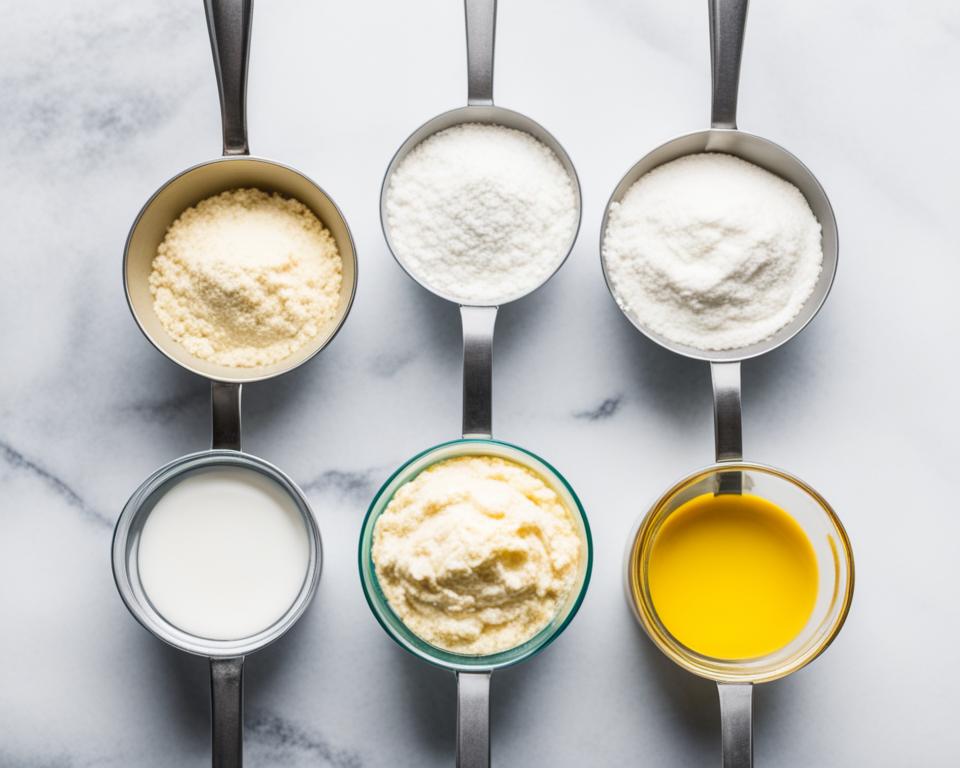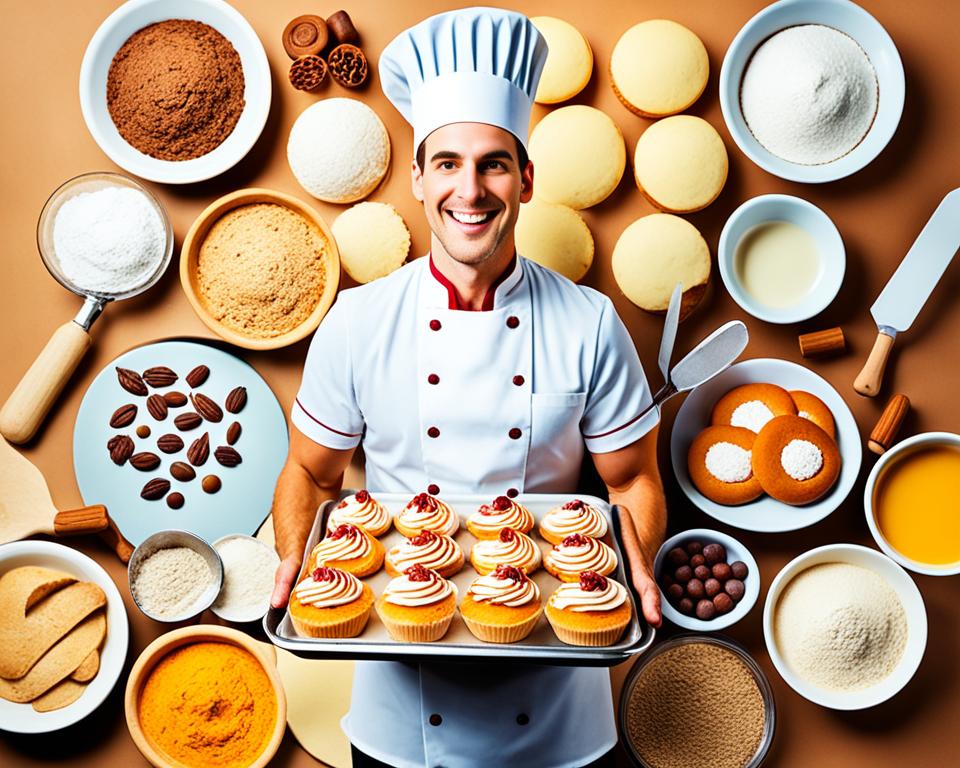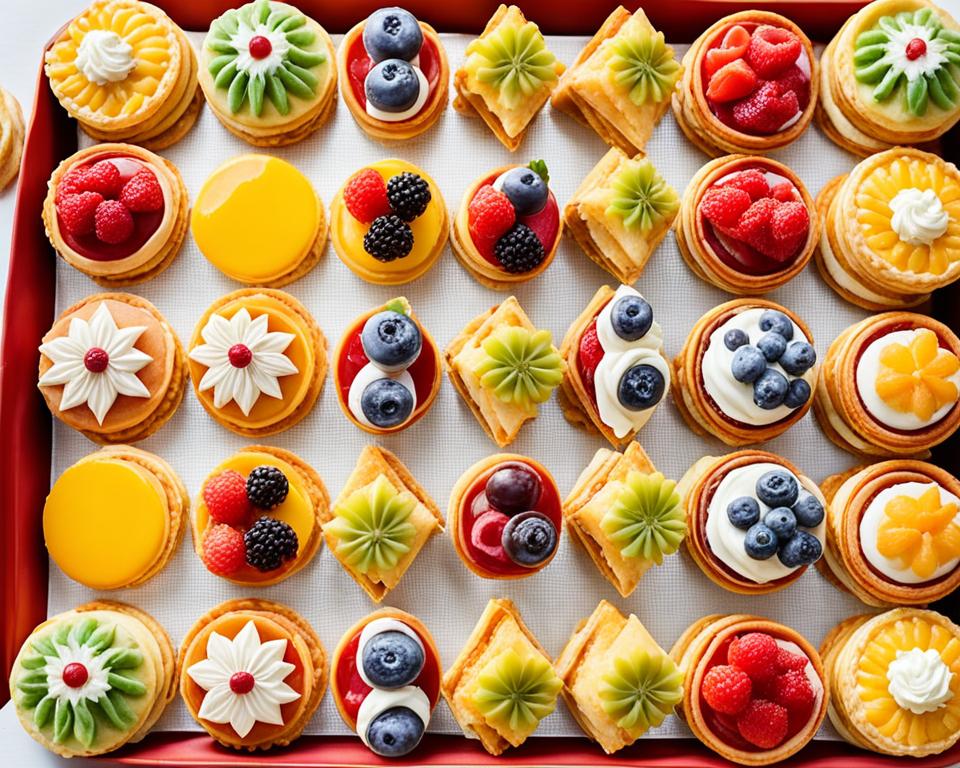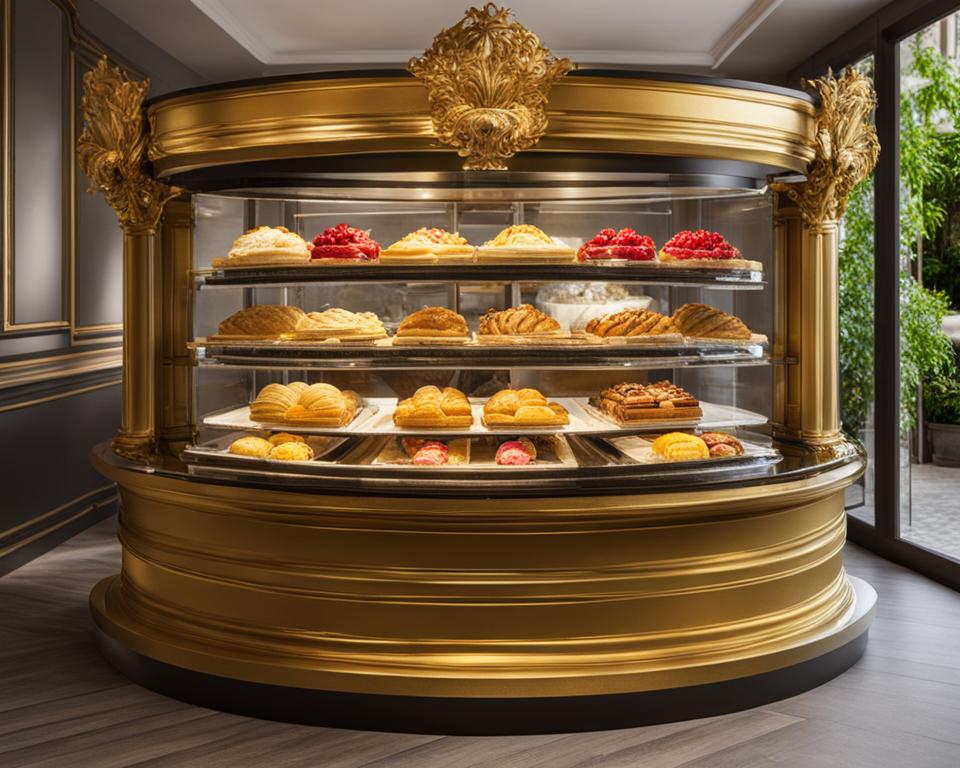Baking can be intimidating, but with the right strategies, you can achieve perfect bakes every time. Whether you’re a seasoned baker or just starting out, these foolproof baking tips will help you avoid common mistakes and ensure delightful results.
From measuring properly to using quality ingredients, these fail-proof baking techniques will set you up for guaranteed baking success. With foolproof recipes, baking hacks, fail-safe baking methods, and foolproof baking secrets, you’ll have all the tools you need to create delicious treats that impress.
Key Takeaways:
- Accurate measuring is essential for successful baking. Learn the spoon and level method for dry ingredients and use clear measuring cups for liquids.
- Room temperature ingredients are crucial for proper texture and structure in your baked goods. Take the time to bring butter and eggs to the right temperature.
- Ensure your oven is properly calibrated by using an oven thermometer. Maintain a stable temperature for even baking.
- Avoid making ingredient substitutions unless the recipe provides alternatives. Baking is a precise science.
- Avoid overmixing your batter to prevent tough or chewy textures. Follow recipes’ instructions for mixing techniques.
With these foolproof baking ideas, you’ll be able to achieve consistent and delicious results every time you step into the kitchen. So don’t let baking intimidate you anymore—unlock your baking potential with these fail-proof strategies!
Measure Properly
Accurate measuring is essential for successful baking. When it comes to achieving perfect bakes every time, precision is key. By measuring your ingredients properly, you can ensure the right balance of flavors and textures in your baked goods. Here are some essential measuring techniques to help you achieve accurate measurements:
The Spoon and Level Method
When measuring dry ingredients such as flour, it’s important to use the spoon and level method. This technique ensures that you’re not accidentally adding too much flour, which can result in dry and dense baked goods. Here’s how to do it:
- Take a spoon and lightly stir the flour in its container to loosen it.
- Use the spoon to scoop the flour into the measuring cup, filling it slightly more than needed.
- Take a flat-edged utensil, like the back of a knife, and level off the excess flour by running it across the top of the measuring cup.
This method helps to create consistent measurements each time, ensuring that you don’t accidentally add too much or too little flour to your recipe.
Clear Measuring Cups for Liquids
When measuring liquid ingredients such as milk or oil, it’s important to use clear measuring cups with clear markings. This allows you to accurately measure the liquids at eye level, preventing over or under-measurement. Fill the liquid to the appropriate level indicated on the measuring cup for precise quantities.
Remember to avoid packing flour into the measuring cup, as this can lead to excessive amounts and affect the texture of your baked goods. Instead, spoon the flour gently into the measuring cup and level off the excess.
Avoid estimating or eyeballing measurements, as this can result in inconsistent results. By following proper measuring techniques, you can ensure that your baked goods turn out consistently delicious.
Now that you know how to measure properly, let’s move on to another essential step in baking – using room temperature ingredients.
Use Room Temperature Ingredients
When it comes to baking, room temperature ingredients play a crucial role in achieving the perfect texture and structure in your baked goods. Using ingredients like butter and eggs straight from the fridge can lead to undesired results, such as improperly creamed butter or curdled batter. To avoid these issues, it’s important to bring your ingredients to room temperature before getting started.
Bringing ingredients to room temperature allows for better incorporation and distribution of fats throughout the batter. This is especially important when it comes to butter, as room temperature butter can be easily creamed with sugar to create a light and fluffy texture in your baked treats.
Quick Tip: To bring butter to room temperature quickly, cut it into small cubes and let it sit at room temperature for about 30 minutes. If you’re short on time, you can also soften butter in the microwave in 5-second intervals, making sure to check and rotate it frequently to prevent melting.
Eggs, another essential ingredient in baking, are best used at room temperature as well. Room temperature eggs incorporate more easily with other ingredients, helping to create a smoother batter and a more even rise during baking. To bring eggs to room temperature quickly, place them in a bowl of warm water for about 5-10 minutes before using them in your recipe.
By using room temperature ingredients in your baking, you’ll ensure that your batter is properly mixed and that your baked goods turn out light, tender, and delicious.
Check Your Oven Temperature
A properly calibrated oven is essential for consistent baking results. Ensuring that your oven is at the accurate temperature is crucial to achieving perfectly baked goods.
One way to ensure the accuracy of your oven’s temperature is by using an oven thermometer. This handy tool allows you to monitor the temperature inside your oven, giving you confidence in the accuracy of your baking temperature. Simply place the thermometer inside your oven and adjust the temperature settings accordingly.
It’s important to avoid opening the oven door too frequently during baking. Every time you open the door, heat escapes, causing fluctuations in the oven temperature. These fluctuations can disrupt the baking process and lead to inconsistent results. To maintain a stable temperature, resist the temptation to peek too often and trust the oven thermometer to keep track of the internal temperature.
“Maintaining a stable oven temperature is crucial to achieving evenly risen and perfectly baked goods.” – Baking Expert
By checking and controlling your oven temperature, you can ensure that your baked goods rise evenly and bake to perfection. Whether you’re baking delicate cookies or fluffy cakes, maintaining the right temperature will help you achieve consistent and delectable results.
| Benefits of Checking Oven Temperature | Tips for Accurate Baking Temperature |
|---|---|
|
|
Don’t Make Substitutions
Baking is a precise science, and it’s important to follow recipes closely to achieve the desired results. Making ingredient substitutions can greatly impact the outcome of your baked goods, leading to unpredictable and potentially disappointing results.
When you come across a recipe, it’s crucial to understand the role of each ingredient and how they interact with one another. Each ingredient has a specific purpose, whether it’s for texture, structure, flavor, or leavening. Making substitutions can throw off this delicate balance and affect the final product.
While it can be tempting to make substitutions based on personal preferences or ingredient availability, it’s best to refrain from doing so unless the recipe specifically provides alternatives. Experimentation is better suited for recipes that don’t rely on precise measurements and baking chemistry.
“Baking is a precise science, and making substitutions can throw off the delicate balance of ingredients, leading to unpredictable results.”
To highlight the importance of following recipes, consider the example of using baking soda and baking powder. These leavening agents work differently in recipes, with baking soda requiring acidic ingredients to activate and baking powder working with liquids. This balance is crucial for proper rising in your baked goods.
By sticking to the original recipe and avoiding substitutions, you can ensure the best possible outcome. You’ll be able to enjoy the intended texture, flavor, and structure that the recipe creator intended.
With that said, it’s always a good practice to read through a recipe before starting. This will give you a better understanding of the ingredients required and allow you to plan accordingly. It’s also helpful to have all the ingredients measured and prepared in advance, making the baking process smoother and more enjoyable.
Remember, baking is a combination of science and art. Following recipes and understanding the chemistry behind them will set you up for success in the kitchen. So resist the temptation to make substitutions and embrace the beauty of baking as it was intended.
Use A Light Hand
Mixing techniques play a crucial role in achieving the perfect texture for your baked goods. Overmixing can result in tough or chewy textures, which is not desirable for delicate cakes and muffins. It is important to understand the impact of gluten development on the final outcome of your bakes. Gluten, a protein found in flour, provides structure and elasticity to bread. However, excessive gluten development can lead to a dense and chewy texture in cakes and muffins.
To ensure a tender and fluffy texture in your baked treats, it is essential to avoid overmixing. Follow the recipe’s instructions and stir the batter only until it is uniform. Be careful not to overmix once flour is added to prevent excessive gluten formation. This will result in a light and tender texture that melts in your mouth.
+ Avoid overmixing to prevent tough or chewy textures in baked goods.
+ Follow the recipe’s instructions and stir only until the batter is uniform.
+ Be cautious with flour addition to prevent excessive gluten development.
To emphasize the importance of mixing techniques, consider this quote:
Chefs at Baker’s Delight emphasize the need for a light hand when it comes to mixing batter. Overmixing can result in undesirable textures, so it’s important to know when to stop and achieve that perfect tender crumb.
Comparison of Mixing Techniques:
Let’s compare the effects of different mixing techniques on the texture of baked goods:
| Mixing Technique | Texture |
|---|---|
| Overmixing | Tough, chewy |
| Gentle mixing until uniform batter | Tender, fluffy |
Understand Leavening Agents
Baking powder and baking soda play a crucial role as leavening agents in many recipes, contributing to the proper rise and texture of your baked goods. It’s essential to understand their different activation methods to achieve successful baking results.
Baking powder is a combination of an acid (usually cream of tartar) and an alkaline (usually baking soda). When liquid is added to the batter or dough, the acid and alkaline react, producing carbon dioxide bubbles that cause the mixture to rise. Baking powder is typically used in recipes that already contain acidic ingredients, such as yogurt or buttermilk. It provides consistent leavening without the need for additional acidic components.
Baking soda is pure alkaline and requires the presence of acid in the recipe to activate its leavening properties. When combined with acidic ingredients like lemon juice, vinegar, or brown sugar, baking soda releases carbon dioxide bubbles, leading to the rise of the batter or dough. It’s important to follow recipes that include baking soda precisely, as the correct balance of acid and soda is crucial for proper leavening.
Depending on the recipe, you may need to use both baking powder and baking soda. The combination provides a more substantial rise and is especially important for recipes that require a lot of moisture or have a dense texture. Using the appropriate leavening agent or combination thereof ensures that your baked goods will rise beautifully, resulting in light, fluffy, and evenly cooked treats.
Add Ingredients in Little Piles
Organized baking is crucial for accurate recipe execution. By arranging your ingredients before starting, you can ensure precision and avoid missing any components. One effective technique is to add ingredients in little piles. This method allows you to visually track what has been added, reducing the chances of omission and guaranteeing accurate measurements throughout the baking process.
To implement this technique, gather all the ingredients required for your recipe. Place each ingredient in a designated spot or small pile on your workstation. As you add each ingredient to your mixing bowl, remove it from its corresponding pile.
This simple yet effective visual tracking method helps you stay organized and ensures that you don’t miss any vital ingredients. It also minimizes the risk of accidentally omitting an essential component, resulting in a perfectly executed recipe.
If you enjoy baking with others or have multiple recipes in progress, you can use separate spaces or bowls for each set of ingredients. This will further enhance ingredient tracking, preventing any confusion or mixing up of ingredients.
Take advantage of this organized baking approach to streamline your recipe execution and achieve consistent and delicious results. Whether you’re baking a delicate cake or a complex dessert, adding ingredients in little piles will help you stay on track and ensure the success of your culinary creations.
Line Pans With Parchment Paper or Heavy Duty Nonstick Foil
Properly preparing your baking pans is essential for achieving even baking and easy removal of your baked goods. By lining your pans with parchment paper or heavy-duty nonstick foil, you can ensure hassle-free cake release and prevent sticking. Both parchment paper and nonstick foil offer their own unique benefits.
Parchment Paper:
Parchment paper is a versatile and handy tool in the kitchen. It is a nonstick and heat-resistant paper that provides a protective barrier between your baked goods and the pan. The paper’s natural nonstick properties prevent your cakes, cookies, and other baked goods from sticking to the pan.
One of the advantages of using parchment paper is that it can be reused multiple times before it loses its effectiveness. After baking, simply remove the parchment paper from the pan and wipe off any excess crumbs or residue. This makes for easy cleanup and ensures that your next batch of baked goods will release just as effortlessly.
Professional Silicone Mats:
In addition to parchment paper, another excellent option for lining pans is a professional-style silicone mat. These thick and durable mats are designed specifically for nonstick baking. They offer a reliable and long-lasting nonstick surface that prevents your baked goods from clinging to the pan.
Silicone mats provide a consistent and even baking surface, ensuring that your cakes and cookies bake evenly from edge to edge. They are also dishwasher-safe, making cleanup a breeze. With proper care, a professional silicone mat can last for many years, making it a worthwhile investment for any baking enthusiast.
Below is a table summarizing the benefits of parchment paper and professional silicone mats for lining your baking pans:
| Lining Option | Benefits |
|---|---|
| Parchment Paper | – Nonstick surface for easy removal – Reusable, reducing waste – Heat-resistant and versatile |
| Professional Silicone Mats | – Durable and long-lasting nonstick surface – Provides even heat distribution – Dishwasher-safe and easy to clean |
Using parchment paper or professional silicone mats will ensure that your baked goods come out of the pan effortlessly and that they bake evenly. Whether you choose to use parchment paper or invest in professional silicone mats, these preparations will make your baking experience more enjoyable and your results consistently fantastic.
![]()
Prepare Baking Pans Properly
Properly preparing your baking pans is essential for easy cake release. To ensure even coverage and mess prevention, there are a few methods you can use:
-
Greasing pans: Apply a thin layer of butter, shortening, or oil to the inside of the pan using a pastry brush or paper towel. Make sure to coat the bottom and sides evenly to prevent sticking. This method works well for cakes, bread, and other baked goods.
-
Nonstick spray: Using a nonstick cooking spray with flour, such as baking spray, ensures even coverage and easy release. Simply spray the pan from a distance of about 6 inches, holding it over the sink or open dishwasher to catch any overspray.
Tip: For an extra layer of protection, you can also line the bottom of the pan with parchment paper or heavy-duty nonstick foil.
By greasing or using nonstick spray, you create a smooth barrier between the batter and the pan. This prevents your baked goods from sticking, allowing for effortless removal and presentation.
Now that you know how to prepare your baking pans properly, it’s time to start baking!
| Baking Pan Preparation Methods | Benefits |
|---|---|
| Greasing pans | Ensures even coverage |
| Nonstick spray | Convenient and easy to apply |
Note: Image depicting greasing pans for even coverage and mess prevention.
Measure and Scoop Batter Evenly
Achieving consistent batter measurement is key to even baking. To ensure uniform sizes and evenly baked treats, consider using cookie scoops or ice cream scoops with triggers to measure batter for cookies, muffins, and cupcakes. These tools not only save time and make the process more efficient but also provide consistent and professional-looking results.
Cookie scoops and ice cream scoops with triggers are designed to measure and scoop batter in predetermined amounts, resulting in consistent sizes and even baking. With a simple squeeze of the handle, the batter is released, making it easy to portion and deposit onto baking sheets or into muffin tins.

Using these scoops eliminates the guesswork and ensures that each baked treat is the same size. This is particularly important for cookies, as consistent sizes allow for even baking, preventing some cookies from being undercooked while others are overcooked.
Efficiency and Accuracy
Not only do cookie scoops and ice cream scoops with triggers offer consistent batter measurement, but they also contribute to a more efficient baking process. By using these scoops, you can quickly and accurately portion out the batter without the need for additional tools or measuring cups.
“Cookie scoops are a game-changer in the kitchen. They make the task of measuring batter so much easier and faster. Plus, the consistent sizes result in beautifully uniform cookies every time!” – Jane Baker
Additionally, these scoops are designed to release the batter cleanly and effortlessly, minimizing mess and allowing for precise placement on baking surfaces. This not only saves time during the baking process but also makes cleanup quicker and more manageable.
Professional-Looking Results
Using cookie scoops or ice cream scoops with triggers not only ensures consistent sizes and efficient baking but also adds a professional touch to your baked goods. The uniformity in size creates an attractive presentation, especially when serving cookies, muffins, or cupcakes for special occasions or events.
When placed side by side, cookies of the same size give your baked goods a polished and visually appealing look. This can impress guests, making them think your treats were purchased from a bakery.
Baking Tip:
For even more precision, level off the batter in the scoop using the back of a knife or a spatula. This will remove any excess batter and further ensure consistent portion sizes.
Incorporating cookie scoops or ice cream scoops with triggers into your baking routine is a simple yet effective way to achieve consistent batter measurement, resulting in evenly baked treats with minimal effort. Take your baking to the next level by investing in these handy tools and enjoy professional-looking results every time!
Conclusion
By implementing these no-fail baking strategies, you can achieve baking success and create perfect bakes every time. From measuring properly to using quality ingredients, following these tips will set you up for achievable results. With a little practice and attention to detail, you’ll be able to impress friends and family with your delicious and foolproof baked goods.
Remember, accurate measuring is crucial for consistent baking. Use the spoon and level method for dry ingredients and clear measuring cups for liquids to ensure precise measurements. Additionally, always use room temperature ingredients to achieve optimal texture and structure in your baked treats.
Don’t forget to check your oven temperature and invest in an oven thermometer for accurate baking. Avoid making ingredient substitutions, as baking is a precise science with specific ingredient interactions. Use a light hand when mixing to avoid overmixing and achieve tender and fluffy textures.
Understanding leavening agents and adding ingredients in little piles will also contribute to your baking success. Properly prepare your baking pans by lining them with parchment paper or nonstick foil for easy removal and even baking. And finally, measure and scoop batter evenly to ensure consistent results and efficient baking.
With these no-fail strategies, you have all the tools you need to unlock your baking potential and create perfect bakes. So go ahead, step into the kitchen, and let your baking skills shine!
FAQ
How should I measure ingredients properly for baking?
Measure dry ingredients using the spoon and level method and use clear measuring cups for liquids. Avoid packing flour into the measuring cup and be precise with your measurements.
Why is it important to use room temperature ingredients in baking?
Room temperature ingredients are crucial for proper texture and structure in baked goods. Cold butter cannot be properly creamed, and cold eggs can curdle the batter.
How can I check the accuracy of my oven temperature?
Use an oven thermometer to ensure the accuracy of your oven’s temperature. Avoid frequently opening the oven door to maintain a stable temperature.
Should I make ingredient substitutions in baking recipes?
It is best to avoid making ingredient substitutions unless the recipe specifically provides alternatives. Baking is a precise science, and substitutions can lead to unpredictable results.
How can I prevent overmixing in baked goods?
Follow recipes’ instructions and avoid overmixing. Stir the batter only until it is uniform to achieve tender and fluffy results.
What is the difference between baking powder and baking soda?
Baking powder requires liquid ingredients to activate, while baking soda requires acidic ingredients. Some recipes may call for both to achieve the desired rise.
How can I stay organized when baking?
Organize your ingredients before starting and add them in little piles to visually track what has been added. This helps ensure accuracy and prevents omission of vital ingredients.
How should I prepare my baking pans for easy removal of baked goods?
Line your pans with parchment paper, heavy-duty nonstick foil, or professional-style silicone mats to ensure easy release and even baking.
What is the best way to grease baking pans?
Use nonstick spray or greasing methods to ensure even coverage. Hold the pan over the sink or open dishwasher to avoid mess.
How can I achieve consistent batter measurement for even baking?
Use cookie scoops or ice cream scoops with triggers to measure batter for cookies, muffins, and cupcakes. This ensures uniform sizes and even baking.
How can I guarantee baking success?
By following these no-fail baking strategies, such as proper measuring, using room temperature ingredients, and understanding leavening agents, you can achieve perfect bakes every time.




